 |
|
||
|
|||
|
It was after a hard drive through heavy bottom lands, across rivers, creeks and bayous, over long stretches of dripping prairie, and now and then a wooded section, that we entered a great park-like estate on the east bank of the Tres Palacios. From afar I had observed what appeared to be a big thicket skirting the range. On nearer approach I discovered it to be a hedge of rose bushes from twenty to thirty feet high, from fifteen to twenty feet wide, and thirty-seven miles long. It stretched as far as the eye could see. The driver alighted, opened the gate that marked the only gap in this impenetrable hedge, and as the horses walked within the confines of the estate I could see, far off toward the distant river, one of the most beautiful homesteads in all this southern country. It may have been the long, dreary ride through the quagmires of the Caney bottoms, it may have been the hard pulling over the water-soaked prairies of the Colorado River, or both, that lent enchantment to the view, but whatever the reason, I am sure that no more charming picture was disclosed to me than that when I first gazed upon el Rancho Grande. It was like drawing aside a somber curtain and presenting a masterpiece of art. The broad expanse of level prairie between the rose hedge and the homestead was like a velvety lawn. High-bred cattle browsed upon the rich verdure. Remember, this was mid-December on the southern coast. The air was laden with fragrance. The sun was just low enough in the great dome to show this homestead in its most picturesque and hospitable garnishment. With a glorious background of noble oaks and lordly elms, the pure white of the main building had a perfect setting. The smaller structures on either side served to heighten the charm of the picture. In any part of the North or East, where beautiful homes and well-kept estates abound, such a scene would command attention, but in south Texas, in a country little-known and seldom traversed, in a country where the whistle of a locomotive has never been heard, it is no wonder that the sight evoked from me an exclamation of rapture. As we approached the buildings new beauties were discovered to our view. The prairie was dotted with Indian pinks and primroses, buttercups and daisies, marigolds and verbenas, while within the confines of the garden near the house, chrysanthemums and majestic roses, nodding in the gentle breeze, bade us welcome. I had never heard of Jonathan E. Pierce until a few weeks ago, and I had never seen him until the day I drove up to his house. While we sat in his room late at night smoking, I asked him to tell me the story of El Rancho Grande. He laughingly declared there was not much to tell, and then, in bits and snatches, with occasional digressions as the recollections of the days of long ago awakened other subjects for conversation, he narrated the story of his life. He was born in Rhode Island fifty-eight years ago, he told me. The farm his father owned was poor but every art known to the skillful and scientific agriculturist was practiced to add to its productiveness. The elder Pierce taught his children to do thoroughly and well anything and everything they undertook. He impressed upon them the virtue of patience and perseverance. Thirty-seven years ago, when but a raw youngster, Jonathan Pierce came to Texas. He knew how to farm, he knew carpentering, he knew blacksmithing, he knew plumbing. He thought there was in the great state of Texas a chance for a young man to advance in the world more rapidly than in the crowded East. What he saw when he began life in Texas was different from what he imagines, but he never forgot the principles inculcated by his father. He went to work for a cattleman named Grimes and received $20 a month. The life was very hard and the food was very rough. He inquired why vegetables were not grown and was laughed at. He was told the soil of Texas was no good for anything but cattle. There was little else in Texas those days but cattle. The men who told him Texas soil was no account were older than he and had been in Texas longer, but he was not satisfied. When the opportunity offered, he broke ground and planted a little patch of such vegetable seeds as he could procure. The result was a handsome crop. There were vegetables in Grimes’ household after that, and more respect was shown for the young Yankee’s judgment. But Jonathan Pierce hadn’t come to Texas merely to show the Grimes family how to grow vegetables. He loved rugged life and was ambitious and was ambitious to make a name and fortune. “Old Grimes” was one of the leading cattlemen of the state and his cowboys traversed the whole country tributary to the Texas ports. In all his trips over the prairies and through the valleys of Texas, the young cowboy from New England never saw a more beautiful spot that the one on the banks of the Tres Palacios River at what is called Deming’s Bridge, in Matagorda County. The next time he saw it he drove some stakes in the ground and resolved that there he would, if life was spared to him, and his fortune prospered, make his home someday. Then he rode away and followed the herd, but he never forgot the land where the oaks and the elms grow so thick, and he dreamed of the day he would live there and have his own herds of cattle. The young Rhode Islander was broad-shouldered and keep-chested. With his mechanical skill he was invaluable in a country where artisans were scarce, careless and slipshod, but he always did his best. Owing to his great strength he could do more work than two ordinary men. Soon it got to be a recognized fact that if John Pierce (the Jonathan was contracted to John) did a thing it was all right and there could be no question about the workmanship. While a jack of all trades and master of many, he was always trying to learn something more and always strove to widen his spheres of usefulness. Ordinary cowboy life was too narrow for a man of his handiness and soon he branched out in various ways. He took contracts to do work and when it was pointed out to him that he could make more money if he used lighter material and did not carry out all the details so thoroughly he said there was only one way to do a thing and that was to do it right. On that rock he built his reputation. With a fund of good, hard common-sense, with indomitable determination, love of work and plenty of ambition, young Pierce was not slow to make headway. The money he earned he put into cattle and land. He always had an abiding faith in the value of land. In partnership with his brother A. H. (Shanghai) Pierce he kept steadily adding to his worldly store. For twenty-six years the brothers were in partnership. During that time Shanghai did the outside or trading work and Jonathan looked after the ranch interests. Shanghai became known from one end of the United States to the other, but Jonathan was seldom heard of except among the cattle men of south Texas. In the twenty –six years the wealth of the Pierce brothers grew enormously. Shanghai pinned his faith to cattle. Jonathan pinned his to cattle and land. About the first bit of land that Jonathan purchased was the strip of land on the Tres Palacios that he had staked out some years before. In the twenty-six years the brothers were together they never quarreled. When they dissolved they had a vast domain to divide. I asked Jonathan Pierce how much he is worth; how many acres of land he has and how many head of cattle he owns. He laughed but wouldn’t answer. Then I asked him about his ranches. “I have this one, which I call El Rancho Grande,” said he. “and the one you see below, which is the Pilkington Slough ranch and south of that is the Oyster Lake ranch. At Tulsa, in the Creek nation, Indian territory, I have another.” I remarked that El Rancho Grande was appropriately named. “I think it is,” Mr. Pierce replied. “I confess I am proud of it. I have lived to see the ambitions of my youth realized. For thirty-seven years I have lived in this country and I have given my best energies to make a home, a reputation and a fortune. I hate to leave things as I found them and I constantly try to improve. Idleness brings vice. I am never idle myself and my men are happy because I treat them well, pay them well, and keep them busy. One of my men has Aunt Eliza, the colored woman you saw, was a slave owned by Old Man Grimes when I was a cowboy working for $20 a month for him.” I asked Mr. Pierce how it came about that he had the rose hedge. “That hedge,” he said, “will prove a blessing to the cattle men of Texas. I planted it to keep out horse thieves and other depredators. The thief who will penetrate a rose bush hedge is hardly fit for business after the trip. It was solely a defensive measure against thieves that I planted the bushes, but I soon found out that they were a much greater utility. The soil in that part of Texas is very rich and the bushes grew as you have seen. The hedge not only forms a pretty barrier to mark the outlines of the various pastures, but it serves as a windbreak and when the northers blow the cattle seek the shelter the hedge affords and are protected. It is the cold sharp wind that more than anything else kills cattle, and with these windbreaks the loss is minimized. I have thirty-seven miles of this hedge, and I will have twenty or twenty-five miles additional in a year or two. If you want to see the hedge in all its glory come here in the spring or summer. The whole thirty-seven miles of hedge is then one great blaze of rose blossoms and the perfume of the air hereabouts is so sweet that those who visit us say they are in paradise. Other stockmen are now putting in this rose bush hedge and soon I expect most of the rich pastures will be protected and adorned in this way.” When I remarked to Mr. Pierce that his home was a remarkably comfortable and well-built one, and that he seemed to be on of the few men who had realized all his early hopes, he smiled and said: “Why, you haven’t seen one-half of what I have here. I am, to be sure, proud of this home. I think I know the carpenter business and I superintended the building of this house. I believe it is the best built dwelling in all Texas. You could roll it over and over and not break off enough wood to make a toothpick. Every bit of lumber in this house is as good as lumber can be. Why, there’s 2200 pounds of galvanized nails in it, too. The walls would stand a siege.” Mr. Pierce was right when he said I hadn’t seen the half of what he has at El Rancho Grande. I had seen a church steeple off to the north, but I didn’t know until later that the church was part of El Rancho Grande. Neither did I know that the building nearby was El Rancho Grande’s Masonic Temple. When I took a list of the other buildings that go to make up this great establishment, I had to write down an office, two carriage-houses, one barn, a saddle house, a crib, a hide house, a store house, a gear house, a smoke house, a white men’s house, a negro men’s house, a carpenter shop, a blacksmith shop, a hide press, a hay house, a potato house, a cotton feed house, a hog house, a goat shed, a hen house, a tool house, which they call the “department of state,” and a cotton gin which is said to be the finest in the state. |
In driving over the wide prairies that form part of El Rancho Grande I had seen at points about five miles apart great windmills, forty-five or fifty feet high about which the cattle gathered. I asked Mr. Pierce how many of these great windmills he had on his estate. He told me eighteen, and, in addition, he had two immense reservoirs to the south, in the neighborhood of the Pilkington Slough ranch. With the reservoirs and eighteen windmills the cattle are guarded against drought in the long hot summer. I drove from El Rancho Grande eighteen miles south, to the Slough ranch, and from the Slough ranch I drove seven miles south, until I stood on the spot, I am informed, where Stephen F. Austin landed his first colony. It is this site that the G.A.R. committee is negotiating with Mr. Pierce for. Here the G.A.R. colony will be located if the gentlemen agree on terms. It was to examine this site that I had made the trip from the Brazos river overland to the remote region in which I was now traveling. As I stood on the bluff overlooking the pellucid waters of Tres Palacios bay, the wild ducks and the wild geese flew by in covey. On the left was a pretty bayou that broadened out into what is known as Oyster Lake. On the road down the driver had called my attention to a herd of deer, while wild turkeys and other game abounded. I was told some great stories of tarpon fishing and redfish and red snapper catching. In the bay and its estuaries, I was informed, there are turtles and oysters in abundance. I could not but appreciate the beauty of this whole region. Creeks, bayous and arroyos drain the land so well that despite the recent heavy rains and the fact that the road I followed was little more than a trail, travel was easy. We had passed through four great pastures that seemed to me to be of about the same proportions, and I inquired if there was any significance in the division. I was informed that each of these pastures contained 5000 acres, and that Mr. Pierce had given to each of his four children an independent estate, stocked each of the pastures with cattle, and kept the accounts of each child’s interest separate. Of these four independent estates, the one in the highest of improvement is that owned by John Pierce, Jr. Young John Pierce has his father’s love of the soil and his father’s mastery of detail. Perhaps 1000 acres of the 5000 in young John’s portion are in cultivation. It looks more like an Ohio or Illinois farm than a Texas Ranch. Young John, too, has his father’s mechanical traits. His house is fitted throughout with running water and bath rooms and all accessories to good living, while the buildings are models of neatness, comfort and graceful appearance. Each of the strips of land owned by the children fronts on Tres Palacios river. On the banks of the river, on the land of young John Pierce’s a pretty yacht, the Nomad, was moored. Nearby a good-sized steam launch, which will be christened El Vaquero, was being built. El Vaquero will be about 45 feet long, and will accommodate about forty persons. It will have eighteen horse power and will be used by the Pierce family and their friends in hunting expeditions along the Tres Palacios and Matagorda and Espiritu Santo waterways. Although Mr. Pierce did not tell me how many acres of land he owns or how many thousands of cattle he possesses, I could form a fair idea of the magnitude of his interests from this short trip to the Slough Ranch. In the “patch” which the G.A.R. people are negotiating for there are 20,000 acres. There are 20,000 acres in the portions allotted to the children for pin money. These are distinct from El Rancho Grande. On the west of the Tres Palacios there are more great pastures and on Matagorda Peninsular (sic) there are more lands that Jonathan Pierce owns. It would be conservative, I think, to put his landed interests at 200,000 acres. I saw the pile of abstracts of his lands. Packed away in one of the great safes in his office, they make a stack nearly three feet high. When it is understood that lands in that part of Texas are rarely bought by cattlemen in less than 640 acre tracts, it can be appreciated what that formidable pile of documents represents. Of his cattle it is difficult to form a fair estimate, but I know he has in one “bunch” 15,000 head. Of blooded stock he has more than 500 bulls. Among these are Galloways, Durhams, Devons, Herefords and Brahmas of high degree, many of them being registered. No account is taken in this list of his ranch in the Indian territory. I believe all told, 30,000 head of cattle. When I told Mr. Pierce that I thought he had the most magnificent ranch in the world and that he seemed to have everything man could desire, he said that he felt his life had been well spent. “I have lived,” said he, “to see all the dreams of my youth fulfilled. I am now beyond the need of money. You wouldn’t think I was 58 years old, would you? I work today with the same heartiness and relish I did when I was a young man. I love to work. I can do more hard work to-day than any man I employ. Thirty-seven years on a Texas ranch tells the story of why I look to-day a man of 40 instead of being an old man. But although I still feel the zest for work and although the ambitions of my early days have all come to fruition, I have new hopes and new plans. I expect to see them realized. Man is, I believe, to a large extent the architect of his own destiny. I have never wronged a man in my life and I have tried to live so that my children and my children’s children will be proud of their ancestry. In all my life, although my business has been large, I have never sued a man. “Men whose fortunes were great when I was a $20 a month cowboy I have seen brought to poverty; men who were struggling, hustling youngsters like myself I have seen rise to wealth and affluence. I have never seen a drone succeed. The busy bees rarely fail of reward. “This beautiful country through which you have been traveling has been long held as the domain of the cowmen. It has been necessary in order to preserve these great pastures to keep out immigration. This is, I believe, one of the most fruitful regions on the face of the globe, but so far the cattlemen have succeeded in keeping out the homeseekers. Now we realize that we can no longer keep them from invading this region. One railroad, the Galveston, Brazos and Southwestern, has already surveyed a route through this county. Another line is projected. The day of great pasturage tracts in this part of Texas is closing. Soon this whole southern Texas country will be cut up into small parcels of land. It is beyond the power of man to check the tide. The cattlemen did all they could to maintain this rich land for themselves, but now the time has come when they will be driven out. “I will stay here as long as I live. When I die I will be placed in the cemetery up near the church you saw. But I expect that will not be for many a year, and in the meantime I want to enjoy some of the luxuries in life that I have not had in the thirty-seven years I have been here. “It does not seem to me so very long ago since big ocean steamers came into the bay below here through Port Cavallo. There was plenty of water on the bar in those days. Many a vessel I have loaded with cattle. I expect to see the government, stimulated by the demands of the commerce of the great west, develop more deep water harbors along the Texas coast. A cut of a mile through Matagorda peninsula would make Tres Palacios bay a deep water harbor. If that is ever done the Tres Palacios river will become an artery of commerce. To-day I can load a schooner of seven feet draught at my pier at Deming’s Bridge. What I dream of now is seeing a busy bustling town there on Tres Palacios point and of having a thriving little town here near El Rancho Grande. I want to have electric light and electric cars. I want to see beautiful homes along these charming streams. I will give $10,000 cash and half of a town-site to the Galveston, Brazos and Southwestern road. “Each summer I take a journey to the north and east. Living as I have in this cattle country for thirty-seven years, I naturally seek the centers of population. Oh, I enjoy life. And I mean to enjoy it, honestly, rationally and well. If my plans for the future develop as happily as did my dreams of long ago, I will be busy and contented until I lay down my work. “This region affords all the opportunities for the maintenance of an agricultural community. The courses of the many streams are wooded with live oak and cedar, elms and cottonwood, and as for ash, the trees are the finest in the south. Many of them are four feet in diameter and the first limb is sixty feet above the ground. “You can see that this is almost a floral paradise. Of the agricultural products we can grow cotton, corn and sugar cane, potatoes, onions, beets, cabbage, celery, lettuce, radishes, tomatoes, cauliflower, watermelons, cantaloupes, figs, plums, grapes, pears, peaches; in fact, anything and everything the human family requires. Fish are plentiful and the climate is all that man could desire.” “Mr. Pierce,” said I, “one thing that impressed me forcibly while I have been going over your ranches is that nowhere have I seen a sixshooter. The revolver is generally supposed to be part of a cowboy’s or a ranchman’s makeup.” “The sixshooter was banished long ago,” said Mr. Pierce. “In the old days every cowboy carried a young arsenal. My men were like the others. I determined to stop it. One day I went to the Slough ranch. The boys had their ‘guns’ and cartridge belts strapped on them. I looked at the foreman for a few moments. He had a bigger shooting outfit than the others. Seen any Indians to-day?” I asked. “Indians,” he exclaimed. “Why, no! I haven’t seen any Indians in a long time.” Then I looked at him again. He didn’t understand what I was driving at. Finally I said: “there’s a law in this country against carrying sixshooters. I’m a member of the grand jury. I was just up to my son’s ranch. He had a sixshooter on him. I told him if he didn’t put it away I’d had him indicted. Then I galloped over the prairie toward home. There hasn’t been any sixshooter-carrying on my ranches from that day to this.”
When my horses’ heads were turned toward the Colorado and El
Rancho Grande was disappearing in the distance, I congregated the
various ideas and impressions gathered during my visit and decided
that the man I had just left was a great man, remarkable in many
ways. That he had been favored by fortune may be said, but that he
would have made his mark in any calling there can be little doubt.
Now In the ripeness of his years and experience, with his two sons
and his two daughters grown, with money sufficient to satisfy almost
any one’s desires, with one of the handsomest homes in Texas, and
with an estate greater by far than some of the European
principalities, his herds of cattle adding day by day to his wealth,
he can not but feel that, the dreams of his youth realized in their
fullest, the dreams of later days may yet blossom into realities. |
||
|
The Spillane article above also appeared in the January 11, 1898 issue of the Boston Globe with the following two drawings.
|
|||
 Rancho Grande after the house burned |
|||
|
The first Pierce ancestors in Matagorda County were the family of
William D. Lacy and his wife, Sarah Bright Lacy. Lacy was given a
league and a labor of land along the Tres Palacios River after
signing the Texas Declaration of Independence from Mexico and
serving in the Texian Army. He had come from Paducah, Kentucky, in
1831. His tannery in Columbus, Texas, was destroyed during the
conflict. One of their three daughters, Nannie Deborah (b. August
11, 1845), married Jonathan Edwards Pierce on May 2, 1866, after his
and his brother’s, Abel Head “Shanghai” Pierce, returned from the
Civil War. Jonathan was born in Little Compton, Rhode Island, on December 6, 1839, and joined his brother, Abel, in 1858 to work on the ranch of W. B. Grimes near the present town of Blessing. He became a rancher and cattleman with large holdings, and he and Nannie built “Rancho Grande” on the Tres Palacios. Four children were born to them there: John Phillips, who married Louise Keller; Pearl, who married Dr. Allen J. Smith; Abel Brown; and Grace Harriet, who married William Walter “Pudge" Heffelfinger. Nannie Lacy Pierce was accidently thrown from her carriage and died nineteen days later on February 15, 1896. She was buried in Hawley Cemetery. Jonathan married second Grace Lawrence and their children were: James Lawrence, who married Mary Bull and second Evelyn. After Grace’s death he married Laura Duffield and they had a son, Jonathan E., Jr. Jonathan Pierce, Sr., died on March 29, 1915, in Galveston and was buried at Hawley Cemetery.
Historic Matagorda County, Volume II, pages 405-406 Nannie Lacy Pierce at right |
|||
|
Jonathan Edwards Pierce was a son
of J. E. [D.] and Hannah P. Pierce and was born in the State of Rhode
Island on December 6, 1839, and grew to maturity in his native soil. He came to Texas in the year 1860 and landed at Old Indianola, locating soon afterwards in Matagorda County where he resided until his death.
The decedent was prostrated by illness in October last and he had gradually become weaker until his final dissolution came about nine o’clock in the evening of March 19th at St. Mary’s Infirmary in the city of Galveston, whither he had gone for treatment.
A pioneer citizen has gone to his
reward, leaving behind a host of grief-stricken relatives and
sorrowing friends. The Matagorda County Tribune, April 9, 1915
|
|||
|
“None saw her but love her, None knew her but to praise.”
Newspaper unknown |
|||
|
El Rancho Grande Barns - 2007 |
|||
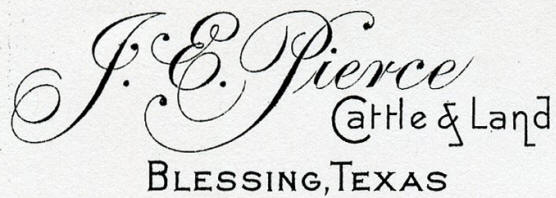


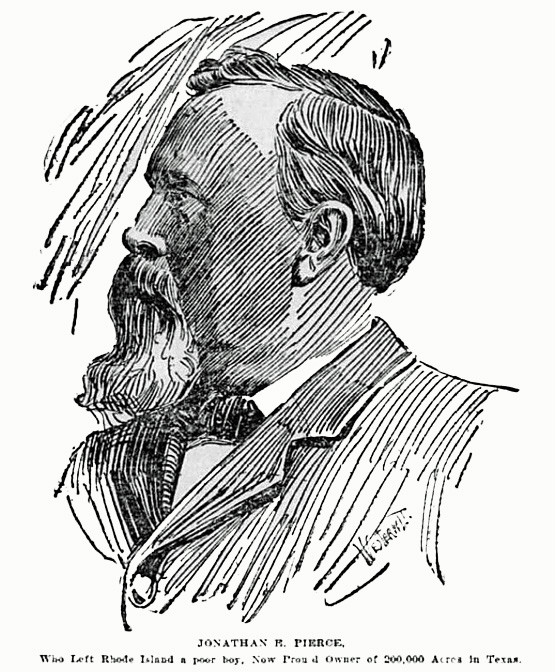
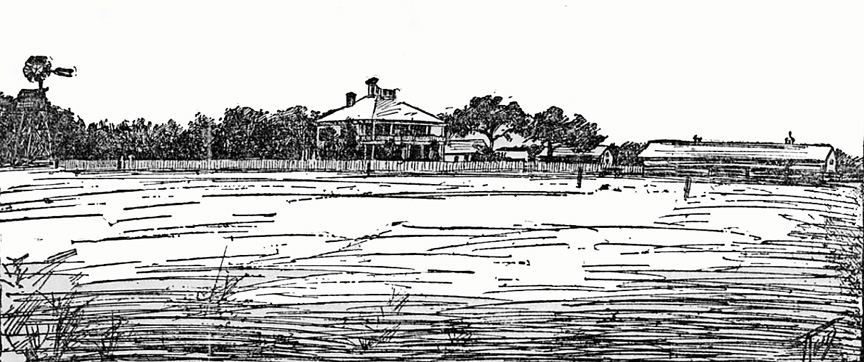





 Present
at the funeral and interment were the following persons from Bay
City: Messrs. Sol J. Cleveland, Frank Vaughan, G. A. Moore, John W.
Gaines, John M. Corbett, W. C. Carpenter, T. J. Poole and several
others.
Present
at the funeral and interment were the following persons from Bay
City: Messrs. Sol J. Cleveland, Frank Vaughan, G. A. Moore, John W.
Gaines, John M. Corbett, W. C. Carpenter, T. J. Poole and several
others.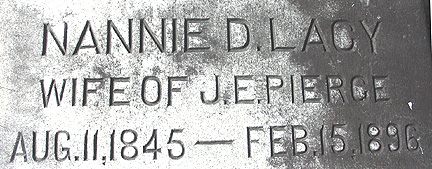 Pierce, Tex., Feb. 22.—Mrs. J. E. Pierce
of Deming’s Bridge departed this life on February 15, 1896. By her
death Matagorda county loses one of its most benevolent and
charitable women. She was a lady of Texas birth; her maiden name was
N. D. Lacy. Her father, W. D. Lacy, was prominently known in
Kentucky. He came to Texas with the famous Stephen F. Austin’s
colony and was a signer of the declaration of Texas independence.
Her
husband, Mr. J. E. Pierce, and her interesting family of four
children, Jonathan P., Pearl L., A. B. and Grace H., all of whom
reside at Deming’s Bridge, survive her. Mrs. Pierce has been noted
for her life’s devotion to her family and for her fervent love of
religion. She was by faith a Baptist, and the church of which she
was the main promulgator stands as a worthy monument of the zeal of
this noble woman. Besides her bereaved family, she leaves a host of
sorrowing friends, whose eulogy with one consent is contained in the
words:
Pierce, Tex., Feb. 22.—Mrs. J. E. Pierce
of Deming’s Bridge departed this life on February 15, 1896. By her
death Matagorda county loses one of its most benevolent and
charitable women. She was a lady of Texas birth; her maiden name was
N. D. Lacy. Her father, W. D. Lacy, was prominently known in
Kentucky. He came to Texas with the famous Stephen F. Austin’s
colony and was a signer of the declaration of Texas independence.
Her
husband, Mr. J. E. Pierce, and her interesting family of four
children, Jonathan P., Pearl L., A. B. and Grace H., all of whom
reside at Deming’s Bridge, survive her. Mrs. Pierce has been noted
for her life’s devotion to her family and for her fervent love of
religion. She was by faith a Baptist, and the church of which she
was the main promulgator stands as a worthy monument of the zeal of
this noble woman. Besides her bereaved family, she leaves a host of
sorrowing friends, whose eulogy with one consent is contained in the
words: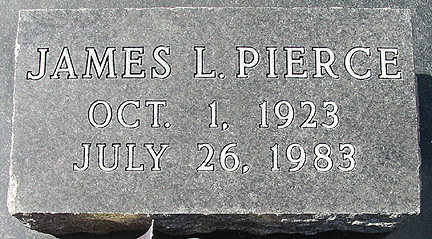
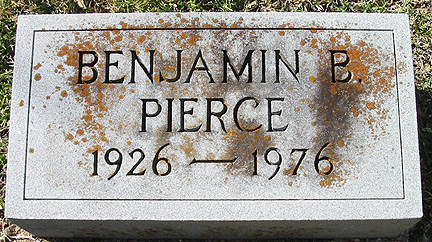
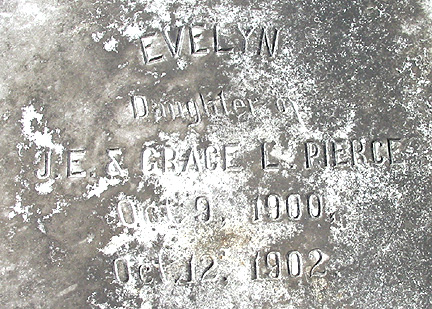
 PIERCE
-- Jonathan E., died June 5, 1993. 30 year resident of Bonita, CA. A
graduate of Tulane University. Recently attended 60th college
graduation reunion. Past President of the S.D. Patrons Tennis Assoc.
and involved in Jr. tennis work. Father of January Crockett, Jeanine
(Robert) Steber and Jonathan E. (Donna Lee) Pierce III. Grandfather
of Joel B. and James T. Gleghorn, Jonathan E. IV. and Christopher W.
Pierce, Clayton D. Crockett, Casandra (Quinn) Early, Courtney
Crockett and Lorana Pierce. Great Grandfather of Cameron and Chance
Early. Preceded in death by wife Olive Vimer Pierce and grandson
Jonathan R. Gleghorn. Visitation Thurs. 9 a.m. Greenwood Mortuary.
Graveside Services and Interment Thursday 2:30 p.m. Greenwood
Memorial Park. Donations to San Diego Animal Shelter appreciated.
PIERCE
-- Jonathan E., died June 5, 1993. 30 year resident of Bonita, CA. A
graduate of Tulane University. Recently attended 60th college
graduation reunion. Past President of the S.D. Patrons Tennis Assoc.
and involved in Jr. tennis work. Father of January Crockett, Jeanine
(Robert) Steber and Jonathan E. (Donna Lee) Pierce III. Grandfather
of Joel B. and James T. Gleghorn, Jonathan E. IV. and Christopher W.
Pierce, Clayton D. Crockett, Casandra (Quinn) Early, Courtney
Crockett and Lorana Pierce. Great Grandfather of Cameron and Chance
Early. Preceded in death by wife Olive Vimer Pierce and grandson
Jonathan R. Gleghorn. Visitation Thurs. 9 a.m. Greenwood Mortuary.
Graveside Services and Interment Thursday 2:30 p.m. Greenwood
Memorial Park. Donations to San Diego Animal Shelter appreciated.